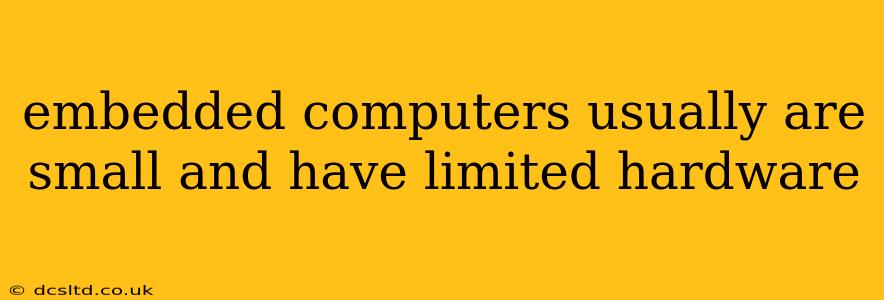Embedded Computers: Power and Limitations in Small Packages
Embedded computers are ubiquitous, silently powering everything from your microwave oven to your car's engine control unit. Their defining characteristic? They're typically small, with limited hardware resources compared to a desktop or laptop. This inherent constraint shapes their design, functionality, and applications in fascinating ways. Let's delve deeper into this world of miniature computing power.
What are the typical hardware limitations of embedded computers?
Embedded systems often face limitations in several key hardware areas:
-
Processing Power: They usually employ less powerful processors (microcontrollers or specialized microprocessors) than general-purpose computers. This translates to lower clock speeds and less processing power, impacting the complexity of tasks they can handle.
-
Memory: RAM and storage capacity are significantly smaller than in desktop or laptop computers. This necessitates careful memory management and often the use of specialized techniques to maximize efficiency. Flash memory is commonly used for storage due to its non-volatility.
-
Power Consumption: Minimizing power consumption is crucial, especially in battery-powered devices. This often means using low-power processors and components, leading to trade-offs in performance.
-
I/O Capabilities: The number and types of input/output interfaces (like USB ports, Ethernet ports, etc.) are often limited to those specifically needed for the device's function.
-
Expansion Capabilities: Unlike desktop computers, expanding the hardware capabilities of an embedded system is often difficult or impossible due to the fixed nature of their design.
What are the advantages of using smaller and simpler hardware in embedded systems?
Despite the limitations, smaller, simpler hardware offers significant advantages:
-
Cost-effectiveness: Reduced hardware complexity directly translates to lower manufacturing costs. This is crucial for mass-produced embedded devices.
-
Lower Power Consumption: Smaller components generally consume less power, extending battery life in portable devices and reducing overall energy costs.
-
Compact Size: Miniaturization is vital for many applications, allowing embedded systems to be integrated into smaller spaces and devices.
-
Reliability: Simpler systems, with fewer components, can be more reliable and less prone to failures.
What types of applications commonly use embedded computers with limited hardware?
The small size and low power consumption make embedded systems ideal for a vast array of applications:
-
Consumer Electronics: Smartphones, smart TVs, microwaves, washing machines, and countless other home appliances rely on embedded systems.
-
Automotive: Engine control units (ECUs), anti-lock braking systems (ABS), and advanced driver-assistance systems (ADAS) all use embedded computers.
-
Industrial Automation: Robotics, programmable logic controllers (PLCs), and other industrial control systems often employ embedded computers for precise and reliable operation.
-
Medical Devices: Pacemakers, insulin pumps, and other life-critical medical equipment rely on robust and reliable embedded systems.
How are software and hardware designed to overcome limitations in embedded systems?
To compensate for limited hardware, sophisticated software techniques are employed:
-
Real-time operating systems (RTOS): These specialized operating systems prioritize tasks based on their timing requirements, ensuring timely responses even with limited processing power.
-
Optimized Algorithms: Efficient algorithms and data structures are crucial to maximize performance within the constraints of limited memory and processing power.
-
Power Management Techniques: Software plays a vital role in managing power consumption, including techniques like clock gating and power-saving sleep modes.
In conclusion, embedded computers, while constrained by limited hardware, are remarkable feats of engineering. Their small size, low power consumption, and cost-effectiveness fuel innovation across diverse sectors. The careful balance between hardware and software design is key to unlocking their immense potential and driving the development of ever more sophisticated and powerful embedded systems.
